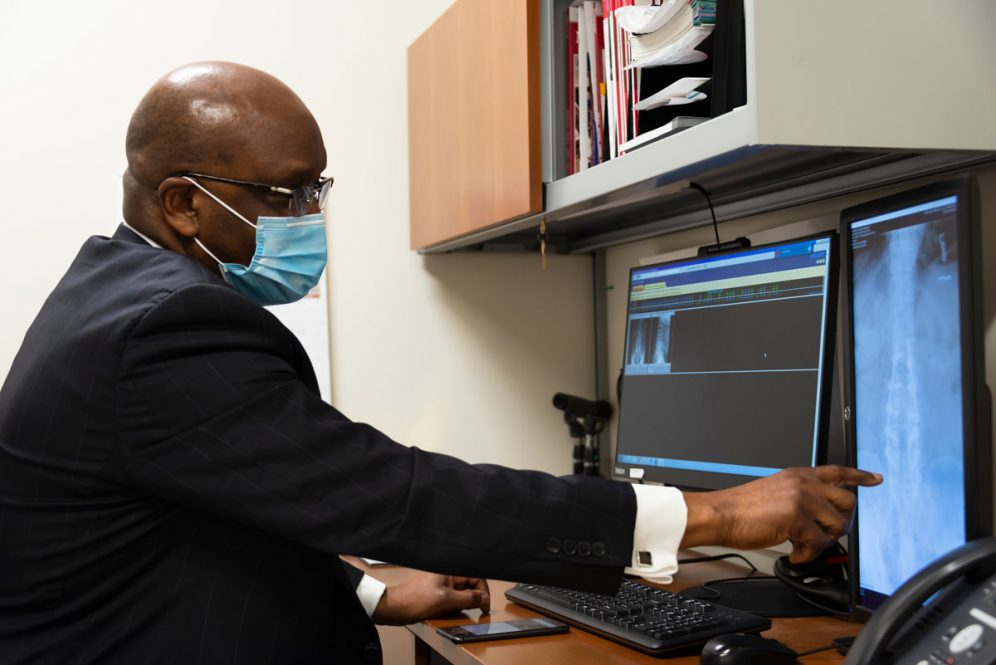A team of UConn Health surgeons and medical students is behind a newly established algorithm for treatment of a condition that causes lower back pain.
Bertolotti syndrome is largely underdiagnosed, in part because physicians and radiologists have to know to look for it, and in part because there simply are many potential causes of back pain.
“You can actually alter somebody’s life functionality, because it’s something that is easy to treat.” — Dr. Hilary Onyiuke
The authors of a paper published in the journal Neurochirurgie came up with the Onyiuke Grading Scale, named for Dr. Hilary Onyiuke, founder and co-director of UConn Health’s Comprehensive Spine Program.
“It’s a therapeutic kind of scale,” Onyiuke says. “Yes, you make the diagnosis, you see what it is, but there was really no direction or guidance on how it could be treated.”
Bertolotti syndrome is a congenital anomaly of the lower spinal structure that is not detectable with magnetic resonance imaging (MRI). Instead it takes traditional x-ray images of the lumbar spine to reveal.
Dr. Isaac Moss, chair of UConn Health’s Department of Orthopaedic Surgery, Dr. Ketan Bulsara, chief of the Division of Neurosurgery, and Dr. David Choi, UConn Health spinal oncology surgeon, are co-authors, along with two physicians who at the time of the research were fourth-year UConn medical students: Dr. Joshua Knopf, now a UConn surgery resident, and Dr. Subin Lee, who is doing a general surgery internship at Rush University in Chicago.
“This is a terrific contribution and a well-deserved honor for Dr. Onyiuke, and for UConn Health,” Bulsara says. “Physicians around the world will use the Onyiuke Grading Scale to guide them as they find relief for their patients’ chronic back pain. That speaks volumes about Dr. Onyiuke’s surgical leadership, which spans both spinal and cranial neurosurgery. Through his thoughtful analysis he distilled a complex problem into a manageable grading scale that will provide generations of physicians guidance on how to treat this potentially debilitating syndrome.”

Guidance on treatment for Bertolotti syndrome can go a long way in improving patient outcomes. It is one of many potential causes of back pain, and there often can be concurrent causes. Identifying Bertolotti syndrome as a cause and treating it nonsurgically could help reduce the need for eventual surgical interventions.
“Let’s say the patient had two spinal pathologies,” Onyiuke says. “One is obvious, a routine one we see, we treat that, and they get better. And then, over time, the Bertolotti will kick up again. Bertolotti syndrome may not be the only problem the patient has, and it certainly can be a secondary problem. But if you don’t treat it, or at least recognize it when you’re treating the primary problem, then you’re going to have a failure at some point.”
The Onyiuke Grading Scale assigns one of four scores:
- The patient’s x-ray shows an anomaly associated with Bertolotti syndrome but no back pain.
- The patient has lower back pain.
- The patient has lower back pain plus pain and numbness in the feet.
- The patient also has a coexisting spinal pathology.
“With this grading, then, it’s a question: Are you symptomatic, or are you not symptomatic,” Onyiuke says. “No symptoms? Grade one, no treatment. But for who have back pain and leg pain, we developed an algorithm where we send them through conservative treatment such as physical therapy, like any other spinal pathology. If they do fine with it, then you don’t need any treatment. If they don’t improve, we’re going to start diagnostic blocks.”
While providing temporary relief, diagnostic nerve blocks also serve to pinpoint sources of pain by injecting anesthetic to specific nerves. Common methods include cortisone injections or radiofrequency treatments.
“If you do well with that, then you don’t need anything else, you can just do that intermittently every few months,” Onyiuke says. “If you don’t, that’s where the surgical component comes in. The surgical component could be a decompression, decompression and fusion, or fusion alone.”
The researchers derived the Onyiuke Grading Scale from the study of Bertolotti syndrome patients at UConn Health in 2018 and 2019.
“You can actually alter somebody’s life functionality, because it’s something that is easy to treat,” Onyiuke says. “It doesn’t necessarily all have to lead to surgery, but in fact, the nonoperative treatment is critical because once you can manage them on that, they don’t need surgery at all.”



